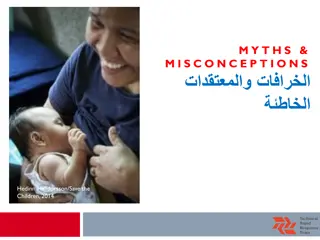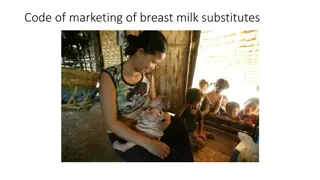Breastfeeding Support in the Workplace: Employers Survey Results
Employers were surveyed on their practices and attitudes towards breastfeeding in the workplace, with most workplaces offering support for breastfeeding employees. However, a notable percentage of respondents were unaware of relevant legislation and believed better support could be provided without bearing additional costs.
Download Presentation

Please find below an Image/Link to download the presentation.
The content on the website is provided AS IS for your information and personal use only. It may not be sold, licensed, or shared on other websites without obtaining consent from the author.If you encounter any issues during the download, it is possible that the publisher has removed the file from their server.
You are allowed to download the files provided on this website for personal or commercial use, subject to the condition that they are used lawfully. All files are the property of their respective owners.
The content on the website is provided AS IS for your information and personal use only. It may not be sold, licensed, or shared on other websites without obtaining consent from the author.
E N D
Presentation Transcript
Breastfeeding at Work EMPLOYERS SURVEY RESULTS
SUMMARY OF RESULTS Women s Health Action surveyed 75 Employers in May, June and July 2015, around practices and attitudes towards breastfeeding in the workplace. Most workplaces (86%) have one or more supports available for staff who wish to breastfeed in the workplace. Similarly, most workplaces (91%) offered women returning to work after parental leave some flexibility in their working hours. Employers were mostly positive about the impact of allowing women to breastfeed or express in the workplace, with most (68%) believing that it would improve morale
SUMMARY OF RESULTS Over one-quarter of respondents (28%) are not aware of the 2008 Infant Feeding Amendment to the Employment Relations Act 2000, which is designed to provide guidance for the protection and promotion of breastfeeding through breaks and facilities. Three quarters of respondents (76%) believe better support could be provided to them to help them support breastfeeding mothers in the workplace. Most, however, would not be willing to pay for these services.
RESPONDENTS The majority of respondents had more than 100 staff in their business or organisation The people who answered our survey came from a range of sectors, however most were in health (26%) or education (15%). Please see Appendix 1 for a breakdown of these figures
MOST WORKPLACES PROVIDE PREGNANT OR BREASTFEEDING STAFF WITH WRITTEN INFORMATION ON FLEXIBLE WORK OPTIONS, AND OFFER FLEXIBLE HOURS OR BREAK TIMES WORKPLACE SUPPORT AVAILABLE FOR BREASTFEEDING EMPLOYEES 55% Written information around flexible work options policies 45% Flexible hours or break times 42% Promote a positive culture to prevent harassment and 41% Customers or clients can breastfeed in public spaces 36% A private place to breastfeed OTHER than a bathroom or toilet 29% Infants can be brought to work for feeds 22% A written policy 16% Employees can bring breastfeeding infants to work 14 per cent, or 11 respondents, have no current support set up or available 14% None of these options 13% Dedicated/designated breast milk storage facilities 12% A nominated liaison person 12% Not sure / don't know Note that respondents were able to answer multiple options, so percentages may exceed 100%
MOST WORKPLACES OFFERED WOMEN RETURNING TO WORK AFTER PARENTAL LEAVE PERMANENT, PART TIME EMPLOYMENT AND SHORTENED WORK DAYS OPTIONS AVAILABLE TO WOMEN RETURNING TO WORK AFTER PARENTAL LEAVE 74% Permanent part-time employment 57% Shortened work day 46% Flexi-time 45% Job-sharing 30% Extended break times 30% Tele-commuting / work from home 9% None of these options 7% Other 4% Not sure / don't know Note that respondents were able to answer multiple options, so percentages may exceed 100%
EMPLOYERS WERE MOSTLY POSITIVE ABOUT THE IMPACT OF ALLOWING WOMEN TO BREASTFEED OR EXPRESS IN THE WORKPLACE ALLOWING WOMEN TO BREASTFEED OR EXPRESS IN THE WORKPLACE WILL 28 1 31 27 8 Have a positive effect on recruitment Have a positive effect on the public image of our business or organisation 31 3 36 24 3 32 1 36 13 9 Improve morale in the workplace 32 1 35 16 8 Decrease staff turnover 23 4 32 24 8 Increase productivity Strongly agree Agree Neutral Disagree Strongly disagree
OVER ONE-QUARTER OF RESPONDENTS ARE NOT AWARE OF THE LEGISLATION WHICH PROTECTS AND PROMOTES BREASTFEEDING IN THE WORKPLACE AWARENESS OF THE 2008 INFANT FEEDING AMENDMENT TO THE EMPLOYMENT RELATIONS ACT 2000, WHICH IS DESIGNED TO PROVIDE GUIDANCE FOR THE PROTECTION AND PROMOTION OF BREASTFEEDING THROUGH BREAKS AND FACILITIES 37% Aware 28% Not aware 35% Not Sure
APPENDIX 1: THE MAJORITY OF RESPONDENTS HAD MORE THAN 100 STAFF IN THEIR BUSINESS OR ORGANISATION NUMBER OF EMPLOYEES 2 to 3 10% 100 or more 36% 4 to 10 23% 51 to 100 11% 11 to 50 20%
RESPONDENTS CAME FROM A RANGE OF SECTORS, WITH MOST IN HEALTH (26%) OR EDUCATION (15%) Other sectors include Agriculture, Forestry and Fishing 6% SECTOR Mining Manufacturing 3% Electricity, Gas, Water and Waste Services Other 16% Retail Trade and Accommodation 13% Construction Arts, Recreation and Other Services 3% Rental, Hiring and Real Estate Services Transport, Postal and Warehousing 3% Financial and insurance services Health Care and Social Assistance 24% Information Media and Telecommunications 7% Public Administration and Safety Professional, Scientific, Technical, Administrative and Support Services 11% Education and Training 14%























